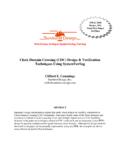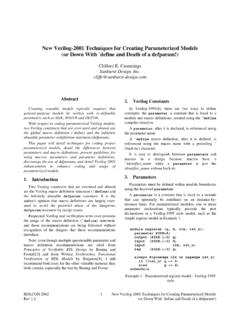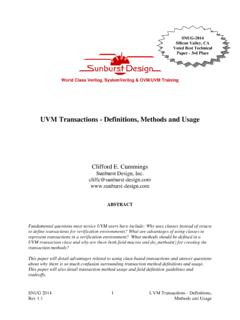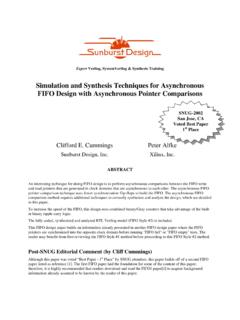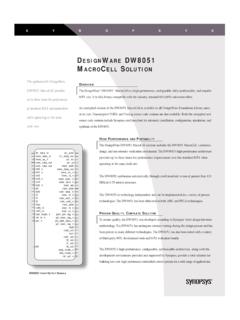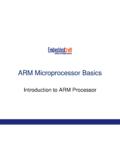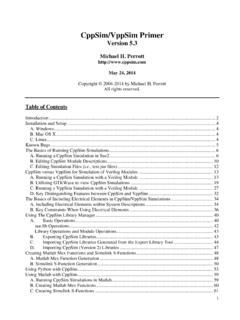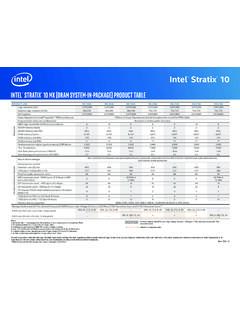Transcription of State Machine Coding Styles for Synthesis - …
1 State Machine Coding Styles for SynthesisClifford E. CummingsSunburst Design, paper details efficient Verilog Coding Styles to infer synthesizable State machines. HDLconsiderations such as advantages and disadvantages of one-always block FSMs Vs. two-alwaysblock FSMs are 1998 State Machine Coding Styles for SynthesisRev Golson's 1994 paper, " State Machine Design Techniques for Verilog and VHDL" [1], is agreat paper on State Machine design using Verilog, VHDL and Synopsys tools. Steve's paper alsooffers in-depth background concerning the origin of specific State Machine paper, " State Machine Coding Styles for Synthesis ," details additional insights into statemachine design including Coding style approaches and a few additional Machine ClassificationThere are two types of State machines as classified by the types of outputs generated from first is the Moore State Machine where the outputs are only a function of the present State .
2 The second is the Mealy State Machine where one or more of the outputs are a function of thepresent State and one or more of the 1 - FSM Block DiagramIn addition to classifying State machines by their respective output-generation type, statemachines are also often classified by the State encoding employed by each State Machine . Someof the more common State encoding Styles include [1] [2] [3]: highly-encoded binary (or binary-sequential), gray-code, Johnson, one-hot, almost one-hot and one-hot with zero-idle (note: in theabsence of a known official designation for the last encoding-style listed, the author selected the"one-hot with zero-idle" title.)
3 A more generally accepted name may exist).Using the Moore FSM State diagram shown in Figure 2, this paper will detail synthesizableVerilog Coding Styles for highly-encoded binary, one-hot and one-hot with zero-idle statemachines. This paper also details usage of the Synopsys FSM Tool to generate binary, gray andone-hot State machines. Coded examples of the three Coding Styles for the State Machine in FigurePresentStateFF sNextStateLogicOutputLogicnextstateclock inputsoutputscombinationallogiccombinati onallogicsequentiallogicstate(Mealy State Machine Only)SNUG 1998 State Machine Coding Styles for SynthesisRev , plus an example with the correct Synopsys FSM Tool comments, have been included at theend of this 2 - Benchmark 1 (bm1) State DiagramFSM Verilog ModulesGuideline.
4 Make each State Machine a separate Verilog each State Machine separate from other synthesized logic simplifies the tasks of statemachine definition, modification and debug. There are also a number of EDA tools that assist inthe design and documentation of FSMs, but in general they only work well if the FSM is notmingled with other AssignmentsGuideline: make State assignments using parameters with symbolic State and using symbolic State names makes the Verilog code more readable and eases thetask of redefining states if necessary. Examples 1-3 show binary, one-hot and one-hot with zero-idle parameter definitions for the FSM State diagram in Figure = 1o2 = 0o3 = 0o4 = 0err = 0i1 * i2 __i1 * i2 * i3i2 * i3 __i2 * i3 * i4__i3 * i4__ __i3 * i4__i1 __ __i2 * i3 * i4 __ __i1 * i2 * i3n_o1 = 1o2 = 0o3 = 0o4 = 0err = 1n_o1 = 1o2 = 0o3 = 0o4 = 1err = 0n_o1 = 1o2 = 1o3 = 1o4 = 0err = 0n_o1 = 0o2 = 1o3 = 0o4 = 0err = 0____nrst__i1 IDLEIDLEi1 ERROR __i1 * i2S3i3S2__ i2S1i1 * i2__i1 SNUG 1998 State Machine Coding Styles for SynthesisRev [2.]
5 0] // synopsys enum code IDLE = 3'd0, S1 = 3'd1, S2 = 3'd2, S3 = 3'd3, ERROR = 3'd4;Example 1 - Parameter definitions for binary encodingparameter [4:0] IDLE = 5'b00001, S1 = 5'b00010, S2 = 5'b00100, S3 = 5'b01000, ERROR = 5'b10000;Example 2 - Parameter definitions for verbose one-hot encodingparameter [4:0] IDLE = 5'd0, S1 = 5'd1, S2 = 5'd2, S3 = 5'd3, ERROR = 5'd4;Example 3 - Parameter definitions for simplified one-hot encodingThe simplified one-hot encoding shown Example 3 uses decimal numbers to index into the stateregister.
6 This technique permits comparison of single bits as opposed to comparing against theentire State vector using the full State parameters shown in Example [4:1] // ERROR is 4'b0000 IDLE = 4'd1, S1 = 4'd2, S2 = 4'd3, S3 = 4'd4;Example 4 - Parameter definitions for one-hot with zero-idle encodingThe one-hot with zero-idle encoding can yield very efficient FSMs for State machines that havemany interconnections with complex equations, including a large number of connections to oneparticular State . Frequently, multiple transitions are made either to an IDLE State or to anothercommon State (such as the ERROR- State in this example).
7 One could also define symbolic State names using the macro-definition compiler directives(`define), but `define creates a global definition (from the point where the definition is read in theVerilog-code input stream). Unlike `define constants, parameters are constants local to themodule where they are declared, which allows a design to have multiple FSMs with duplicatestate names, such as IDLE or READ, each with a unique State , FSM code is written with parameter-defined State definitions, but subsequent codestill includes explicit binary State encodings elsewhere in the module. This defeats the purpose ofusing symbolically labeled parameters.
8 Only use the pre-defined parameter names for statetesting and next- State notes on experimenting with different State definitions using Synopsys generatedbinary, gray and one-hot encodings are detailed in the section, "Synopsys FSM Tool."SNUG 1998 State Machine Coding Styles for SynthesisRev Block State MachineA synthesizable State Machine may be coded many ways. Two of the most common, easilyunderstood and efficient methods are two-always block and one-always block State easiest method to understand and implement is the two-always block State Machine withoutput assignments included in either the combinational next- State always block or separatecontinuous-assignment outputs.
9 This method partitions the Verilog code into the major FSMblocks shown in Figure 1: clocked present State logic, next State combinational logic and outputcombinational Always BlockGuideline: only use Verilog nonblocking assignments in the sequential always : only use Verilog nonblocking assignments in all always blocks used to generatesequential additional information concerning nonblocking assignments, see reference [4].Verilog nonblocking assignments mimic the pipelined register behavior of actual hardware andeliminate many potential Verilog race conditions. Many engineers make nonblockingassignments using an intra-assignment timing delay (as shown in Example 5).
10 There are twogood reasons and one bad reason for using intra-assignment timing delays with reasons: (1) gives the appearance of a clk->q delay on a clocked register (as seen using awaveform viewer); (2) helps avoid hold-time problems when driving most gate-levelmodels from an RTL reason: "we add delays because Verilog nonblocking assignments are broken!" - This is implementing either a binary encoded or a verbose one-hot encoded FSM, on reset thestate register will be assigned the IDLE State (or equivalent) (Example 5).always @(posedge clk or posedge rst) if (rst) State <= #1 IDLE; else State <= #1 next;Example 5 - Sequential always block for binary and verbose one-hot encodingWhen implementing a simplified one-hot encoded FSM, on reset the State register will beassigned all zeros followed immediately by reassigning the IDLE bit of the State register(Example 6).


